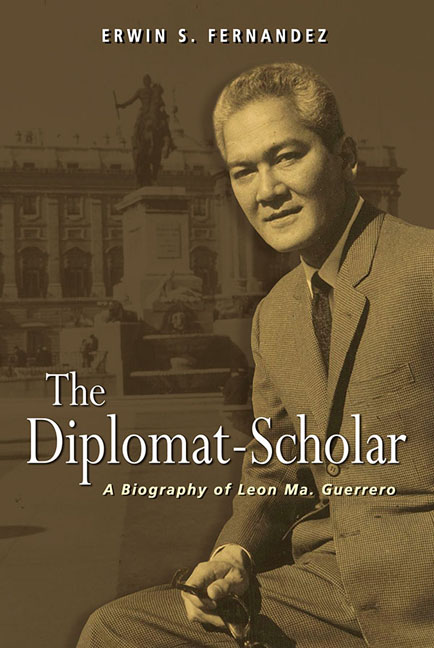Book contents
- Frontmatter
- Dedication
- Contents
- Preface
- Prologue
- Chronology
- I Ermita and Santa Cruz to Intramuros: Between Literary and Legal Career
- 1 Bourgeois Ermita: Birth and Boyhood
- 2 Education under American Jesuits
- 3 The Humorist as Critic, Writer and Actor
- 4 Juggling Law and Journalism on the Eve of War
- II To Tokyo and Back: The Making of a Diplomat
- III Going In, then Out of the Political Jungle: Padre Burgos to Arlegui
- IV London and Madrid: The Philippines in a Resurgent Asia
- V New Delhi to Belgrade: The Philippines towards Non-Alignment
- Epilogue
- Glossary
- List of Abbreviations
- Bibliography
- Index
- About the Author
3 - The Humorist as Critic, Writer and Actor
from I - Ermita and Santa Cruz to Intramuros: Between Literary and Legal Career
Published online by Cambridge University Press: 12 January 2018
- Frontmatter
- Dedication
- Contents
- Preface
- Prologue
- Chronology
- I Ermita and Santa Cruz to Intramuros: Between Literary and Legal Career
- 1 Bourgeois Ermita: Birth and Boyhood
- 2 Education under American Jesuits
- 3 The Humorist as Critic, Writer and Actor
- 4 Juggling Law and Journalism on the Eve of War
- II To Tokyo and Back: The Making of a Diplomat
- III Going In, then Out of the Political Jungle: Padre Burgos to Arlegui
- IV London and Madrid: The Philippines in a Resurgent Asia
- V New Delhi to Belgrade: The Philippines towards Non-Alignment
- Epilogue
- Glossary
- List of Abbreviations
- Bibliography
- Index
- About the Author
Summary
Selected editor-in-chief in March 1931, Leoni dominated the journalistic scene at Ateneo and became a champion of Catholicism, another area of contradictions in his formation (modern-American, Catholic-Hispanic). Under previous editors, Guidon was an outlet for programmes and activities for Catholic action. Under his management, Leoni believed that Catholic college newspapers such as Guidon were necessary to define the position of school authorities like the Ateneo. As editor, he had to beat the deadline for the timely release of the bi-weekly, compelling him and his staff, including Skeezix as associate editor, to work till the wee hours of the day. Believing that four associate editors were enough to fulfil the job, he eliminated the position of news editor but organized the news staff. While constantly on the lookout for innovations and strictly following the schedule, although late releases had to be occasionally put up with, he created a large following because of his witty and funny column.
Initiated prior to his editorship, Leoni's longest-running column “Totoy to Momoy” or “Momoy to Totoy” — patterned as correspondence between two friends — was read by many even beyond Ateneo. Having derived inspiration from American humorist Irvin S. Cobb and English comic author P.G. Wodehouse, Leoni wrote on anything, from plays to carnivals, Christmas to personalities. Outwardly a gossip column, he would occasionally use humour to lampoon various subjects. An American university publication, The Creightonian, praised the peerless humour in every letter, followed by recognition from University of the Philippines (UP) Professor Carlos P. Romulo, adviser to the College Editors Guild (CEG), an umbrella organization of leading student publications from different universities in Manila. While funny to some, others, however, were hurt when they were the subject of Leoni's humour.
Annually, Saint Theresa's College would hold a fair to raise funds for the benefit of the Belgian missions. For one to enjoy the fair and at the same time support the missions, one had to buy tickets sold in booths displaying items for sale or offering games like Truth or Consequence. Leoni, a fair-goer, wrote about the tickets thus: “They'll fleece the sheep and they're fleecing them still.” An irate colegiala confronted Chitang and told her: “Tell your brother he's a real brute!” When she told this to Leoni, he shrugged and laughed it off for he was still the darling of Theresian girls.
- Type
- Chapter
- Information
- The Diplomat-ScholarA Biography of Leon Ma. Guerrero, pp. 39 - 47Publisher: ISEAS–Yusof Ishak InstitutePrint publication year: 2017

